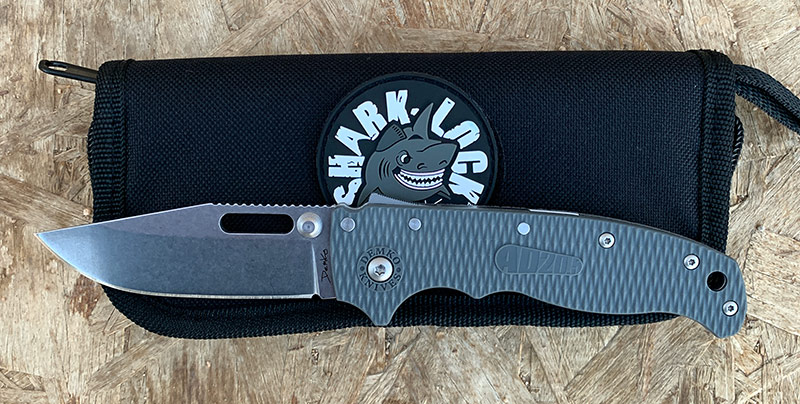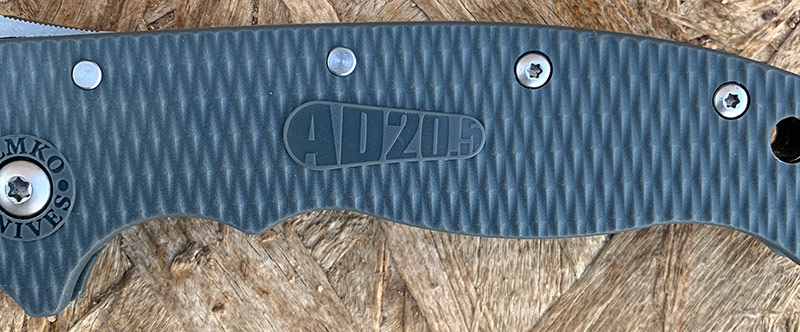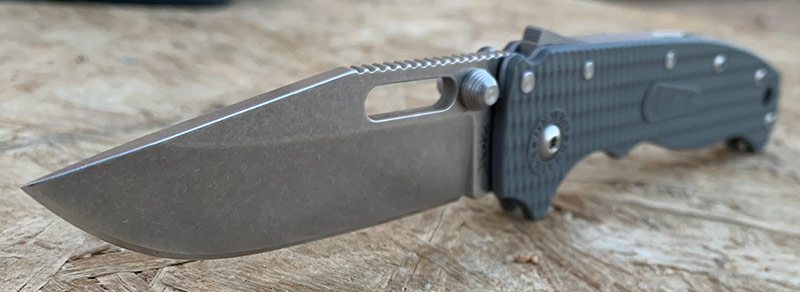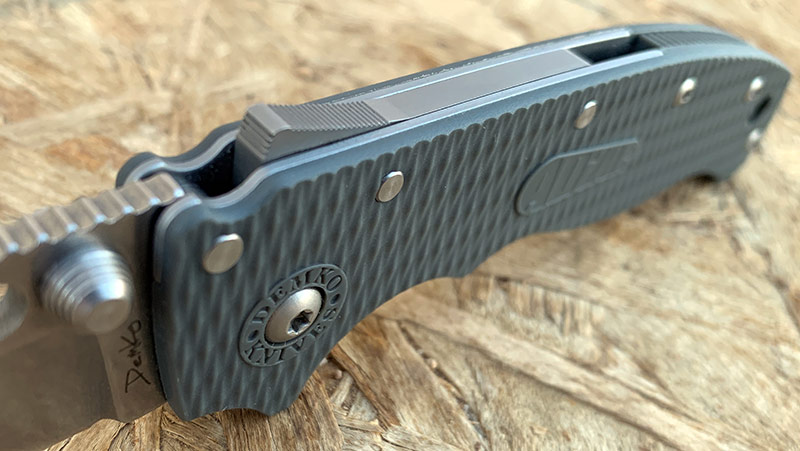We independently evaluate all recommended products and services. Any products or services put forward appear in no particular order. If you click on links we provide, we may receive compensation.

Is the sequel usually better than the original? Or do you prefer the first, original iteration? Today, we’ll look at a knife that’s largely a “version 2.0” of a very popular knife: the Demko AD20.5. Andrew Demko, long time Cold Steel designer, tester and knife maker, set out a couple years back to make a new knife with a new lock, and so became the Shark Lock. Originally found on the Demko AD20, the shark lock uses a new type of mechanism to bring a heavy duty fidget friendly folder with a mean shark fin look to it’s profile.
But, the 20.5 is less of an evolution of the original and more of a cost cutting budget option that was made to put the shark lock in the hands of those who were too unfortunate to miss out on the extremely fast selling AD20’s, with high volume production available to the masses. Cutting down on cost also means cutting down on quality, both in terms of materials and quality, so let’s dissect this shark finned folder and see if it holds it’s own as a standalone knife in the Demko lineup.
Key Specs: Demko AD20.5
Blade
With an option of drop point or “shark foot” blade, and a 3.2” or 3” length respectively, the AUS10A composition is a well implemented choice for a mid-tier knife. And it seems to have been heat treated well, too. The stonewashed finish is nice and even, hides scratches, and has a smooth-to-the-touch feel that aids in resisting friction in cutting. The clip point variant used for our review has a great neutral blade profile, with a gradual sweeping belly, terminating at the tip with a drop down from the spine. Credit to the Demko boys in the category of branding on the blade, as they’ve kept it to a minimum. The show side reads only “Demko”, and the lock side reads the blade steel. The 0.13” blade stock thickness is a great choice for a sturdy build without being unnecessarily thick. The opening thumb studs are comfortable for use, and the addition of the oval opening hole as a secondary option is always a welcome attribute for a fidget friendly folder.

It’s not all roses, though. The grind isn’t bad on the AD20.5, but it isn’t great in terms of thickness behind the edge. In day to day use, it may not always be the best thing to have an incredibly thin edge on a folder for admittedly abusive use from time to time, but the AD20.5 does have a little resistance in use due to the material left on the blade behind the shoulder. And with a flat grind that meets with a high saber grind at the spine, there’s not much room for improvement on that geometry in subsequent sharpening sessions. Again, it’s not a deal breaker or even bad, per se, but it could be a bit better. This will come as no surprise to those savvy to the Demko knife lineup, as it’s quite extensive a list of knives, that the geometry will work for utility purposes, but is not made to be a gift from the gods in slicing and initiating fine cutting tasks.
Deployment / Lockup
And now for what you came for. The magic trick that the Demko brothers have made their claim to fame on. The Shark Lock. As far as deployment, the aforementioned blade studs and opening hole are easy to use, comfortable, and really have no issues. The blade studs, like many knives designed by the Demko’s, are larger on one side, and smaller on the other, with the smaller machined with a slot for removal of the stud to switch the larger side to allow for friendly deployment for lefties. And, for a third opening method, the infamous shark lock can be activated and the blade can be flung open.

The shark lock is quite ingenious, really. It’s quite strong (maybe not as strong as the Tri-Ad lock, also designed by Andrew Demko), but strong enough for most anything a folder could be pushed to do. And, with it’s propensity to be fidgeted with, is very easy to unlock the blade and swing it closed. And, that’s that. Over and over. To your heart’s content. Aside from Benchmade’s Axis lock, there aren’t many knife locks that are more “fun” to use. I personally trust a coil spring like the one found in the shark lock than I do an omega spring, as found in Benchmade’s Axis lock. The Demko lock also has a very finely cut jimping section on the top of the lock to give purchase to the user’s index finger (or thumb) to positively grab and open or close the blade.

My personal tastes may vary compared to the next user, but I prefer a positive and traditional detent on a folder. A detent ball, seated in a liner or frame lock, that sits in the blade in a drilled hole tends to hold the blade closed firmly under most any conditions. Knives that use a spring actuated method of keeping the blade closed always seem to feel like they may come open unintentionally. And that’s admittedly mostly just one knife nerd’s take on it, and it’s likely to never be a safety issue, but it felt warranted to mention how easily the blade can be shaken open without pulling back the lock. This is also partly due to the bearing pivot system used in the AD20.5. As most folder aficionados know, bearings tend to have a lot less friction against the blade in deploying and closing the blade. In a knife like the AD20.5, it makes sense to use a pivot system that allows for a free falling blade, that opens quickly and closes fast, since it’s lock mechanism lends itself to a quick action.

You won’t find the absolute frictionless and silent action of something like a Grimsmo Norseman or Holt Specter here, while these ultra high end folders use ceramic bearings with action as slick as oil on glass, but we’re 1/10th the price point with the Demko, so it justifies the use of steel bearings on the AD20.5. The lockup is quite solid. Knives with washers can sometimes require a bit of play to the blade, like in a Spyderco Paramilitary 2, to allow the blade to move freely in it’s action. But bearings can be run just a tad tighter without extremely tight tolerances due to the bearings rolling against the blade. And all this has an effect on side to side rigidity in lockup. Coupled with the shark lock, with it’s high strength nature and design holding the blade locked, the 20.5 sits locked open extremely tightly. Many knife locks, like the compression lock, the Axis lock, and even most frame locks, have a touch of side to side, and even some back to front wiggle if you look hard enough. I couldn’t muscle any movement on the blade, or back to front wiggle, no matter how hard I tried. The AD20.5 has been well designed, and executed well in machining, allowing for a very tight lockup.
Features, Fit and Finish
Like many overseas counterparts to USA made knives, the AD20.5 has been watered down in the materials department. That’s not inherently bad, but the costs have to be cut somewhere, other than country of origin. The FRN handle scale material featured on the 20.5 is decent in terms of feel, with some checkering type grooves for some texture and added grip. Blade steel, as previously mentioned, is comprised of AUS-10A, down from the higher end steels used on the original AD20’s with steels like CRUWEAR, M390, and 3V. They did choose to keep some partial steel liners to the handle scales, though, which is somewhat of a necessity to hold the shark lock in place, and keeps the scales from having an overly flimsy feel in use.

But, the AD20.5 is put together quite well for it’s price point of about $150, considering other alternatives in the same price range. Yes, the handle scales could be finished more accurately, without burrs left at the seams, but other than this one aspect, there’s not a lot that isn’t done well on the knife. Even the packaging is quite impressive, with a soft zipper pouch included in the box, which is also quite nice for the price. I personally wish they would have spent the money used on packaging somewhere in the machining of the parts, or even in the materials, but it is nice to see a product come out of a well done bit of packaging rather than just a plastic bag, albeit mental justification on the purchase. The stonewashing on the blade, for example, is done well enough that if you were to just see the blade on it’s own, without any text etched on it, you’d likely think it was from an original Demko. The pocket clip matches the blade finish closely, too. The body screws are quite small, and for just about any EDC use that’s not necessarily an issue, but when I take knives apart, I always appreciate hardware that’s on the beefier side. All in all, to be honest, I didn’t have a lot of negative to note down in my use with the AD20.5 in terms of fit and finish, and kept coming back to the solid lockup, easy deployment and unlocking, and decent value for the sum of its parts.
Field Test
Using the AD20.5 gave me mixed feelings. Sometimes it would feel comfortable in hand, sometimes I’d hit a hot spot in use, and the blade geometry isn’t terrible but does translate to some felt resistance in many EDC use scenarios. It’s compact nature lends it to carrying well, with a weight of only 3.5 ounces and a slim overall package of just 0.4” thickness on the handle scales.

Getting into the cutting performance on various materials and use scenarios, simply cutting down some cardboard boxes is always a good place to start, as it’s a commonplace task for an EDC knife. With a well done factory edge, to a standard level of shaving sharpness, the AD20.5 initiates cuts and makes long draw cuts on average cardboard at a mediocre level. The thickness behind the edge really comes into play in usage like this. But I digress from the overly critical nature of mundane tasks brought on by the usage of a knife from someone who tests and uses many, many knives each year. The AD20.5 works when you need it to when tossing out some packaging that needs to be sectioned before fitting into the trash can.

Making cuts in paracord and standard rope isn’t too difficult with the AD20.5, but the thick edge strikes again, and in this kind of test, the thin handle and less-than-premium handle scales begin to agitate the hand. Without a lot of handle to grab, and some spots being left unfinished on the scales, making a harder cut starts to bring out the slightly awkward nature of the ergonomics of the knife. For light use, it’s really no issue, but when some moderate force is required to complete a cut, the distance between the top finger groove and the cutting edge seem too far away from each other. Choking up on the 20.5 isn’t something I’d recommend, as there’s no real choil to stop the index finger from sliding up onto the blade. And in a standard hammer grip, the cutting edge feels further away from the index finger than I’d like. All these aspects mean that the knife wants to angle back in the hand, putting pressure on the palm from the shark lock. While the shark lock has it’s benefits and “fun” nature, it gets in the way in certain types of use. This leverage type cutting makes the knife feel wrong in the hand in just about every way, and while it may not be a type of cut many users need on a constant basis, it’s worth noting for transparency in review.

Tabletop cutting is another type of use I like to put on folders. Holding a knife in-hand doesn’t give true feedback in terms of ergonomics, so pushing the blade down on some sisal rope or tall sheets of thick cardboard allows the knife to really show it’s colors in terms of hot spots or the lack thereof. The AD20.5 is quite thin, and with it’s thick blade geometry, feels lacking in the ability to fill the hand. Coupled with a large finger guard, which prevents the user’s hand from choking up safely (although it can be done on the unsharpened portion of the blade), the handle of the knife wants to angle down while making harder cuts. This all adds up to the handle pushing into an uncomfortable part of the pinky and ring finger area, depending on hand size and grip style, of course. Another point of ergonomic conversation is the shark lock. While it’s very secure, easy to use, and fidget friendly, it is placed in a spot where it can push into the web of the hand between the thumb and palm. Again, it’s only if it’s being held in the hammer grip, and only if it’s a harder type of cut, but with a new style of lock, all aspects of use really need to be covered. Overall, the 20.5 cuts fine, does what you need it to do, and has a durable edge, even with it’s less than perfect ergos and slightly intrusive shark lock placement.
Alternatives
All these knives available at BladeHQ.
To cover the most obvious base in alternatives to the AD20.5, the Demko AD20 is the best comparison since it uses the same lock, and is also the only other knife to use this lock. Unfortunately, as with many small batch mid-tech knives, the AD20 is quite difficult to buy. And the secondary market is, without a doubt, absolutely ridiculous for this knife. Really, don’t pay 2-3 times the original cost of an AD20. It’s a great knife, but not at all worth the gouging prices found all over the internet for the secondary. The AD20 is made in either the “MG” variant, or the “HG”, machine ground, or hand ground respectively. Andrew admits quite frequently that he really doesn’t like to hand grind blades anymore, but still does some here and there to keep the lineup in available knives varying in some degree. I’ve had a full Ti MG AD20, and it’s an insanely well built piece of machinery.
The AD20’s come in premium steels, like Cruwear, CPM 20CV, 3V, D2, and many others. They have either G10, or grivory handle scales. The blade shapes a typically drop points, but they have brached out to the “shark’s foot” (sheepsfoot) blade shape, and some occasional one-offs as well. With the AD20 being solely made by the Demko USA shop, it’s first major differentiation with the 20.5 is addressed. The 20.5 being made in Taiwan may turn off some potential buyers who prefer to keep their purchases in their home country, but many don’t see Taiwan as a negative in terms of manufacturing. Spyderco uses a Taiwan factory for many of their knives, and tends to have a more aggressive heat treat with great fit and finish. But I digress, the 20.5 being made overseas is just one point of comparison to the original AD20.
The AD20 is also priced typically between $425 and $800, which is obviously multiple times the cost of the 20.5. The 20 is a thicker, heavier, larger knife in every dimension, too. 6.1 ounces, 3.7” blade, and higher end steel are the biggest differences between the 20 and 20.5, along with the previously mentioned cost difference, and extremely low availability. These knives typically hit retailers and sell out in 10-30 seconds, assuming the website doesn’t crash at the time of the drop. The AD20 is a beast of a knife though, so if you can get your hands on one for the retail cost, don’t hesitate.

The quintessential knife that compares to almost everything in this class of price is the Spyderco Para 3. It’s been around for years, comes in any color you can imagine, any steel composition you want, comes in a lightweight version, has tons of aftermarket parts available, and stands up to the AD20.5 in almost every dimension, as well as being priced nearly identically. The Para 3, now with S45VN as it’s base steel, is ~$150 at most major online retailers. It has a 3” blade, .15” thick blade stock, and a lock that’s easy to use and very safe with fidget factor rivaling the AD20.5. It’s a knife we all know, and while it’s not loved by everyone, it’s commonly acknowledged to be one of the most usable, trusty, affordable, and ergonomic folders in this class of knife.
Conclusion
The AD20.5 takes the Demko lineup in a new direction. It allows the newly popularized shark lock to be attainable without spending $400-$800 just to see what all the hype is about. Using a less premium steel, AUS-10A, and being manufactured in Taiwan, it may have the nuances of a lesser made knife, but holds it’s own in usability, affordability, strength and value. It may not be the holy grail you’re searching for in a knife to last a lifetime, but it’s a fun knife to use, carry, and appreciate with it’s design background and decent build quality that can be had for a fair price.
- Fun to flip open and closed, moderately priced, easily attainable, good EDC alternative to the original AD20
- Less than perfect fit and finish, thick edge geometry, more expensive than other knives in it’s class
Demko AD20.5
Quality/Performance - 72%
Value for Money - 78%
75%
While it may not be a knife to last a lifetime, the Demko AD20.5 is a fun knife to use, carry, and appreciate without breaking the bank,





